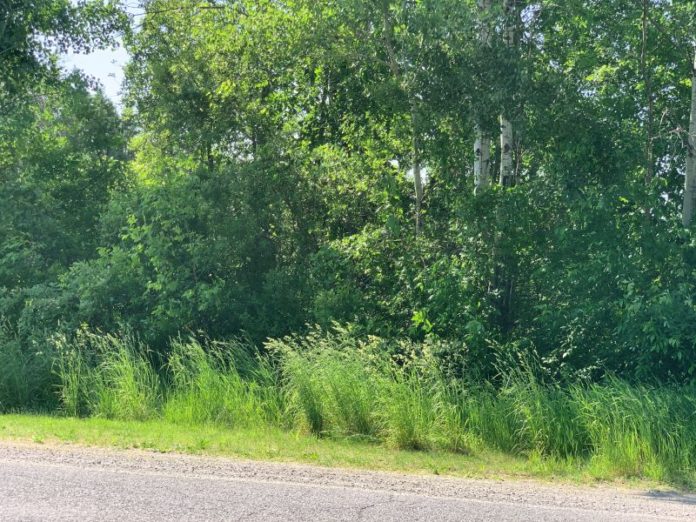submitted by Fred Schueler, Fragile Inheritance Natural History
Brandon Mayer’s recent article “Weed Spraying Facts” provides facts about the excuses that are used for roadside herbiciding, but neglects the question of what’s lost by this practice. Even the final account of why one might put up “No Spray” signs doesn’t include the floral or insect biodiversity that are the major reason the signs are deployed.
The article pitches subservience to the Noxious Weeds Act as a justification for the spraying, but doesn’t give a history of this practice, or present the other options for roadside management, though the floral diversity along provincial highways suggests that this Act doesn’t compel such spraying. If you want to see if your roadsides are scheduled to be sprayed in any year, go to the Counties website at “services/roadside-spraying” – this year in North Grenville, a selection of municipal roads east of Hwy 416 and north of Millars Corners.
Municipal roadside herbiciding ended in the 1980s due to public protests. Then, the one good thing done by the Harris government in the 1990s was to reduce funding for roadside mowing, which has led to continuing spectacular floral displays along the remaining provincial highways, and was initially emulated by counties and municipalities. In the 2010s, herbicide salesmen increased their sales by exploiting concern about “Poison Parsnip,” and indiscriminate spraying suddenly resumed.
My first thoughts on this kind of thing, dating back to the 1960s, was the “Theorem of the Stupid Worker,” which proposes that managers assume their employees are so incapable of learning to distinguish species of plants that they just have to spray indiscriminately. We saw a lot of this as herbiciding was resumed, where Parsnip spraying often took out Milkweed – the food plant of the at-risk Monarch Butterfly – but missed the Parsnips, though recently there has been somewhat better discrimination.
The herbicides used in this spraying only affect broad-leaved Dicot plants, leading to what is called the “Triumph of the Bromes,” where the roadsides are green mostly with wind-pollinated invasive alien grasses, such as Brome Grasses and Reed Canary Grass. There’s also a lot of the non-native dicot Bladder Campion along many roads, and this species is resistant to commonly used herbicides, as is, to a lesser degree, the flouncy Cow-parsley (Anthiscus sylvestris), which is spreading along roads in Brockville and Kemptville.
One of the under-emphasised features of much of eastern Ontario is the absence of native species which haven’t been able to recolonize after a 19th Century of intense wood-cutting, tillage, and grazing. There’s now a long-delayed movement of introducing forest floor herbs (“spring wildflowers”) to plantations and secondary forests, and the same thing ought to be done with native species along roadsides. This is the “pollinator garden” movement. Since roadsides make up such a large portion of public lands, establishing native flora on the roadsides should be a major goal of biodiversity management.
In addition to ending herbicide spraying (except for very particular problems with invasives such as Dog-strangling Vine), this restoration of roadsides should also include the scheduling of mowing with regard to the seasons of bloom of roadside flowers in each community and habitat.
There’s also the question of the nutrient status of the roadsides. Roadsides accumulate mineral plant nutrients (fixed nitrogen, phosphorus, & potassium), both from the nutrients in precipitation that runs off the pavement, and from the bodies of road-killed animals. In the prairie provinces, the roadsides are cut as hay, taking off a substantial amount of nutrients in the plant material. In Ontario, the cuttings are just left to decay, and I think that the resulting accumulation of nutrients encourages roadsides to be dominated by grass. Lower nutrient levels in roadside soil makes room for diverse flowering herbs, though of course excessive nutrient depletion might lead to erosion, so there’s a balance that would need to be maintained if mowed roadside biomass was to be removed and used in some way.
Some of us are beginning the process of diversifying roadsides by sowing the seeds of native Foxglove Beardtongue (Penstemon digitalis) along roads near Bishops Mills. The Environmental Advisory Committee is discussing pollinator gardens on municipal land along Wellington Road, and South Nation Conservation has sown native prairie species in much of the new Mill Run Conservation Area.
We have to hope that management will increasingly take into consideration all aspects of the utility and ecology of the roadsides.







here’s the original article – Schueler, Fred. 2020. Golden-Spangled Lawns. North Grenville Times, 5 August 2020. https://ngtimes.ca/golden-spangled-lawns/ (photo by Aleta Karstad)
^ sorry, that’s the original article for another article. This is the one for this article – – https://ngtimes.ca/weed-spraying-facts/